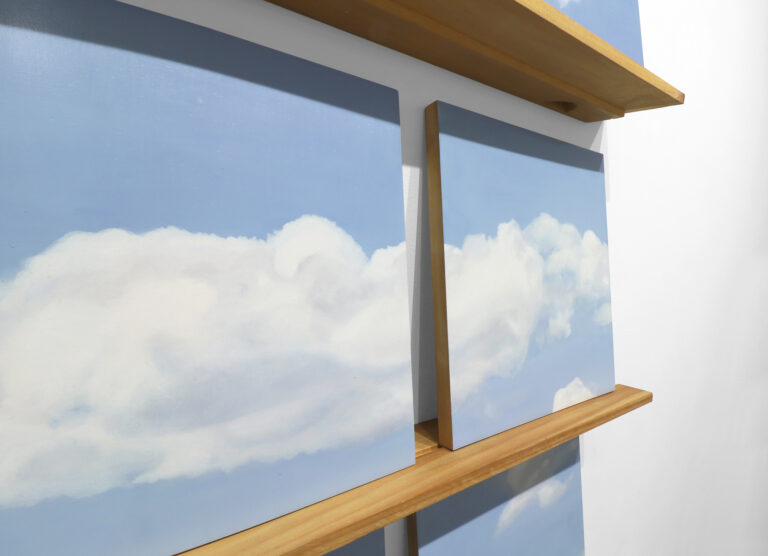Overall size: 37 x 26 x 3 ¼ inches (94 x 66 x 8.25 cm)
(Inventory #21316)
Overall size: 37 x 26 x 3 ¼ inches (94 x 66 x 8.25 cm)
(Inventory #21316)

Panel sizes: 12 x 12 inches each
(30.5 x 30.5 cm each)
Overall dimensions: 54 x 27 x 3 1/4 inches
(137 x 68.6 x 8.3 cm)
(Inventory #20550)
Panel sizes: 12 x 12 inches each
(30.5 x 30.5 cm each)
Overall dimensions: 54 x 27 x 3 1/4 inches
(137 x 68.6 x 8.3 cm)
(Inventory #20550)
37 x 26 x 3.25 inches (94 x 66 x 8.25 cm)
(Inventory #21314)
37 x 26 x 3.25 inches (94 x 66 x 8.25 cm)
(Inventory #21314)
Signed, dated and titled on reverse
Panel size: 36 x 36 x 2 inches (91.4 x 91.4 x 5.1 cm)
(Inventory #24510)
Signed, dated and titled on reverse
Panel size: 36 x 36 x 2 inches (91.4 x 91.4 x 5.1 cm)
(Inventory #24510)
Signed, dated and titled on reverse
Panel size: 36 x 36 x 2 inches (91.4 x 91.4 x 5.1 cm)
(Inventory #24511)
Signed, dated and titled on reverse
Panel size: 36 x 36 x 2 inches (91.4 x 91.4 x 5.1 cm)
(Inventory #24511)
Panel size: 24 x 24 x 1 1/2 inches (61 x 61 x 3.8 cm)
Signed, titled and dated on reverse
(Inventory #25023)
Panel size: 24 x 24 x 1 1/2 inches (61 x 61 x 3.8 cm)
Signed, titled and dated on reverse
(Inventory #25023)
Panel size: 13 x 13 inches each (33 x 33 cm each)
Overall size: 63 x 44 x 5 inches (160 x 111.8 x 12.7 cm)
Signed on reverse
(Inventory #37217)
Panel size: 13 x 13 inches each (33 x 33 cm each)
Overall size: 63 x 44 x 5 inches (160 x 111.8 x 12.7 cm)
Signed on reverse
(Inventory #37217)

1975-77 – Hartford Art School
1978-80 – UCSD, La Jolla, CA
1982 – Whitney Program, New York
1995-present
artist residencies/lectureships/teaching
Harvard University, MIT, UNC Chapel Hill, Wesleyan University
EXHIBITIONS
2014
Koubek Center, Miami, FL
Andratx Center for Art, Mallorca, SPAIN
2013
Barbara Krakow Gallery, Boston, MA
2012
Barbara Krakow Gallery, Boston, MA
Aldrich Museum, Ridgefield, CT
2010
University of Connecticut, Stamford
2009
Barbara Krakow Gallery, Boston
2008
Frederieke Taylor Gallery, NYC
2007
Kohler Arts Center, Sheboygan, WI
2006
Barbara Krakow Gallery, Boston
2005
Frederieke Taylor Gallery, NYC
Indiana State University, Terre Haute, IN
2004
Arti and Armicitae, Amsterdam, NETHERLANDS
Exit Art, “Terrorvision”, NYC
2003
Sanskriti Institute, New Delhi, INDIA
Frederieke Taylor Gallery, NYC
Barbara Krakow Gallery, Boston, MA
2002
Wave Hill, Bronx, NY
2001
Queens Museum of Art, Queens, NY
Frederieke Taylor Gallery, NYC
Barbara Krakow Gallery, Boston, MA
2000
Aldrich Museum, Ridgefield, CT
Barbara Krakow Gallery, Boston, MA
Wethersfield Museum, Wethersfield, CT
1999
Frederieke Taylor TZ’Art Gallery, New York, NY
Hermit Foundation, Plasy, CZECH REPUBLIC
Barbara Krakow Gallery, Boston, MA
Zilkha Gallery, Wesleyan University, Middletown, CT
1987
Stux Gallery, NYC
Hallwalls, Buffalo NY
1986
SUNY at Binghamton, Binghamton, NY
Real Art Ways, Hartford, CT
Webster University, Saint Louis, MO
Dalhousie Art Gallery, Halifax, CANADA
Tweed Courthouse, NYC
Syracuse University, Syracuse, NY
“Mass”,The New Museum, NYC
Currier Gallery of Art, San Francisco, CA
San Francisco Museum of Modern Art, San Francisco, CA
Cornell Cinema, Ithaca, NY
1985
The Image Coop, Montpelier, VT
The Kennell Club, Philadelphia, PA
Ritter Art Gallery, Florida Atlantic University, Boca Raton, FL
Hobart and William Smith Colleges, Geneva, NY
Norman McKenzie Art Gallery, University of Regina, CANADA
1998
College Art Gallery, SUNY, New Paltz, NY
San Jose Museum, San Jose, CA
1997
MIT, Cambridge, MA
Hanes Art Gallery, UNC, Chapel Hill, NC
1996
Katonah Museum, Katonah, NY
1995
Rothschild Gallery, Radcliffe/ Harvard, Cambridge, MA
1994
Kilkenny Castle, Kilkenny, IRELAND
1993
Kunstmuseum des Kantons Thurgau, Warth, SWITZERLAND
Barbara Krakow Gallery, Boston, MA
1992
Irish Museum of Modern Art, Dublin, IRELAND
Wexner Center for the Visual Arts, Columbus, OH
1991
List Visual Arts Center, MIT, Cambridge, MA
“Micro-Colonization, MAB, NYC
1990
“The Totalitarian Zone”, Stalin Monument, Prague CZECH
Goddard-Riverside Community Center, NYC
Ceres Gallery, NYC
1989
University Art Gallery, SUNY at Albany, Albany, NY
“Public Domain”, Kent Fine Arts, NYC
Proctor Art Center, Bard College, Annandale-On-Hudson, NY
1988
“Selections”, Artists’ Space, NYC
New Langton Arts, San Francisco, CA
White Columns, NYC
Houston Center for Photography, Houston TX
Pennsylvania Academy of Fine Arts, Philadelphia, PA
Arizona Center for the Media Arts, Tucson, AZ
Vancouver Art Gallery, Vancouver, CANADA
Fundacion Municipal de Cultura, Valladolid, SPAIN
1984
Walter Phillips Gallery, Banff, CANADA
“Revising Romance: New Feminist Video”, Institute
for Contemporary Art, Boston, MA
“Alibis”, Centre Georges Pompidou, Paris, FRANCE
Hallwalls, Buffalo, NY
Albright-Knox Art Gallery, Buffalo, NY
Mont Beliard Festival, Mont Beliard, FRANCE
University of North Carolina at Greensboro, NC
Centre de Simone de Bouvoir, Paris, FRANCE
1983
University Film and Video Conference, Houston, TX
Detroit Film and Video Project, Detroit MI
Institute for Contemporary Art, Boston, MA
CEPA Gallery, Buffalo, NY
1982
The Kitchen, NYC
Real Art Ways, Hartford, CT
Hallswalls, Buffalo, NY
Artists’ Space,NYC
Woodland Pattern, Milwaukee, WI
1981
Media Study, Buffalo, NY
Montevideo, Hartford, CT
Mudd Club, NYC
1980
New York Avant-Garde Festival, NYC
Del-Mar Drive-In Theater, Del Mar, CA
Roxy Theater, San Diego, CA
San Diego Cablecast, San Diego, CA
Mandeville Center Art Gallery, UCSD, La Jolla, CA
1979
Hartford Art School, University of Hartford, CT
University of Wisconsin at Milwaukee, Milwaukee, WI
“Alternating Currents”, Alternative Museum, New York, NY
Long Beach Museum of Arts, Long Beach, CA
New Langton Arts, San Francisco, CA
Artists’ Space, NYC
Northwest Film Study Center, Portland, OR
Freedman Art Gallery, Albright College, Reading, PA
Artemesia, Chicago, IL
University Gallery, Ohio State University, Columbus, OHIO
University of Rochester, Rochester, NY
Visual Studies Workshop, Rochester, NY
The Kitchen, NYC
Adelphi University, Garden City, NY
American Museum of the Moving Image, Astoria, NY
Southwest Alternate Media Center, Houston, TX
Artculture Resource Center, Toronto, CANADA
10 Newbury Street, Boston, Massachusetts 02116
617-262-4490 | info@krakowwitkingallery.com
The gallery is free and open to the public. Please note our summer schedule:
July 1–25
Tuesday – Friday, 10–5:30
July 29 – September 1
Open by appointment
Beginning September 2
Tuesday – Saturday, 10–5:30